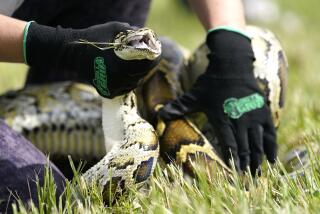‘Super snake’ fears on the rise in Florida
- Share via
Reporting from Fort Lauderdale, Fla. — Fears of a new “super snake” emerging in the Everglades grew this week during a hunt to track South Florida’s invasive python population.
A three-day, state-coordinated hunt that started Tuesday had, by Wednesday, turned up at least five African rock pythons -- including a 14-foot-long female -- in a targeted area in Miami-Dade County.
Those findings add to concerns that the African rock python is a new breeding population in the Everglades and not just the result of a few overgrown pets being released into the wild, according to the South Florida Water Management District.
In addition, state environmental officials worry that the rock python could breed with the Burmese python, which already has an established foothold in the Everglades. That could lead to a new “super snake,” said George Horne, the water district’s deputy executive director.
In Africa, the rock python eats creatures as large as goats and crocodiles. There have been cases of the snakes killing children.
“They are bigger and meaner than the Burmese python. It’s not good news,” said Deborah Drum, deputy director of the district’s restoration sciences department.
The concern is that a hybrid python could pose even more risk of large constrictor snakes overwhelming the Everglades -- where they thrive without a natural predator.
The state estimates that thousands of Burmese pythons have spread through the Everglades. Some came from people releasing exotic pets they no longer wished to care for; others are thought to have escaped during hurricanes and then bred new generations in the wild.
Unusually cold temperatures in South Florida recently have flushed more of the snakes out of the wild and onto flood control levees.
Three of the African rock pythons found in the snake hunt this week were captured, and two got away. One had a circumference of 31 inches. Another was bearing eggs.
The African rock python typically has a “nastier disposition” than the Burmese python, said LeRoy Rodgers, a water district scientist.
“These are animals that are hot predators, and now there are two species to worry about,” he said.
More to Read
Sign up for Essential California
The most important California stories and recommendations in your inbox every morning.
You may occasionally receive promotional content from the Los Angeles Times.










